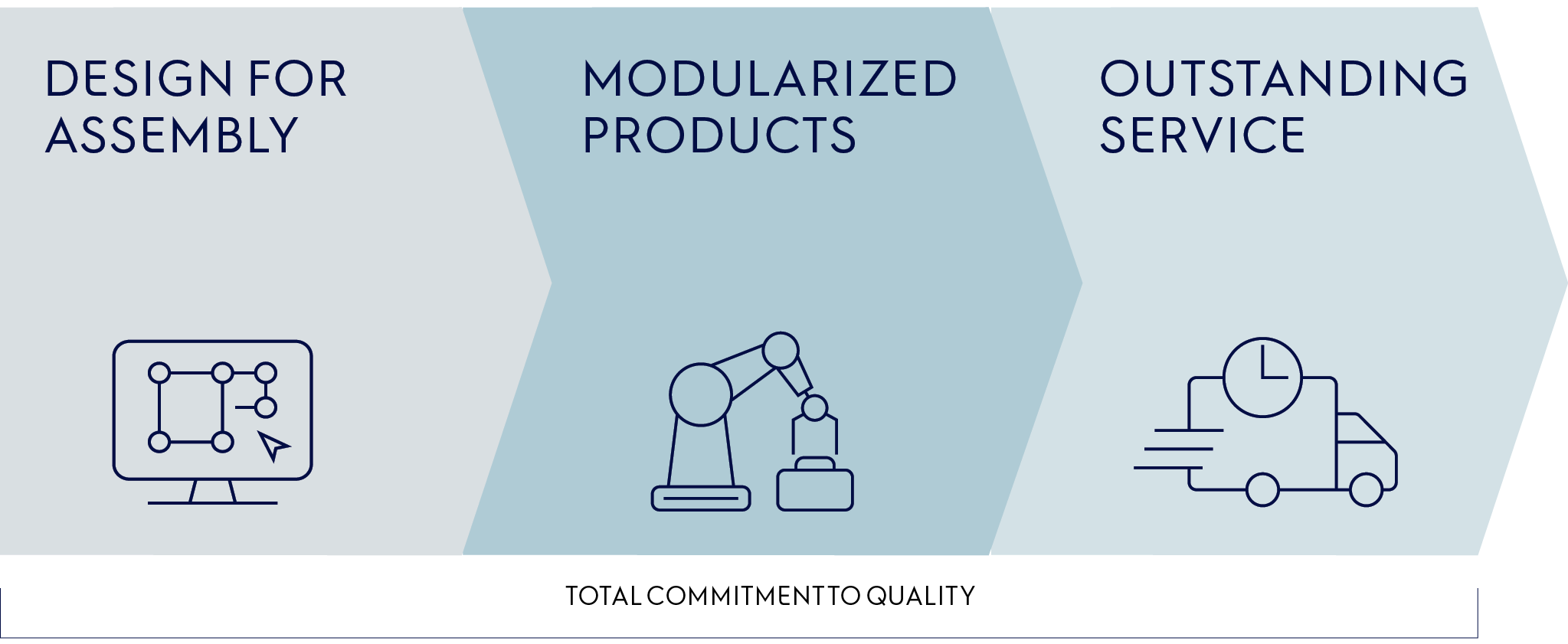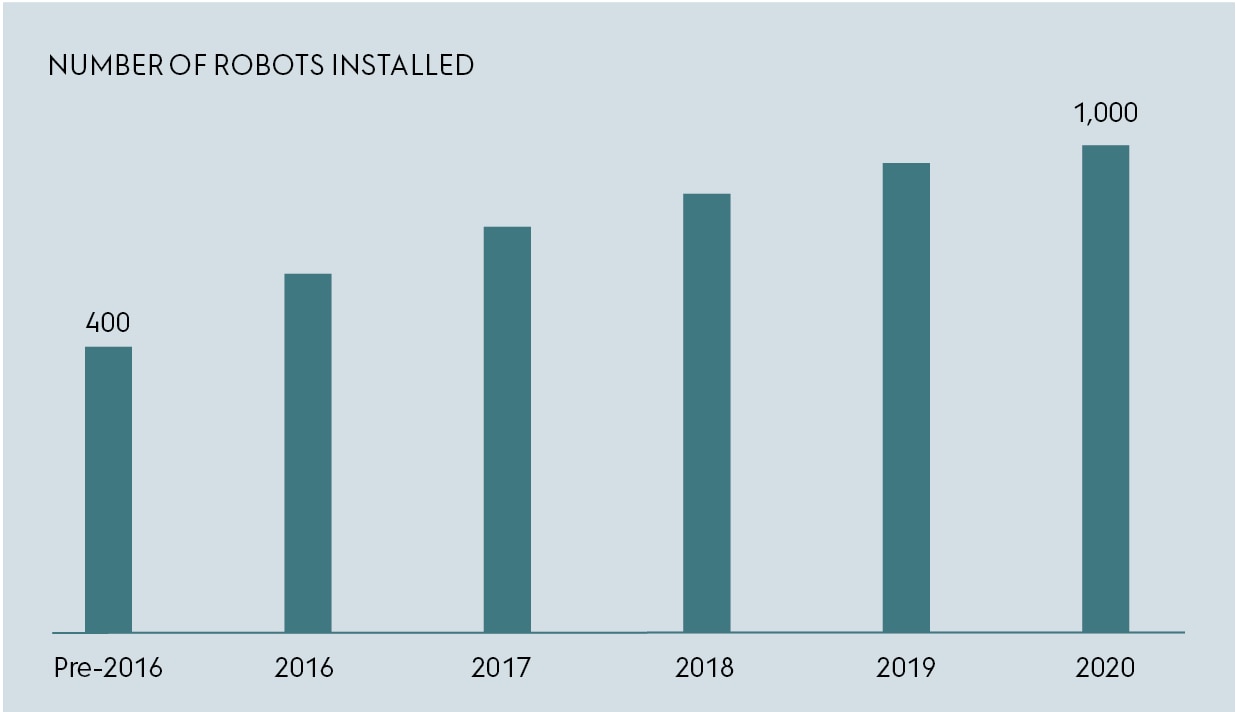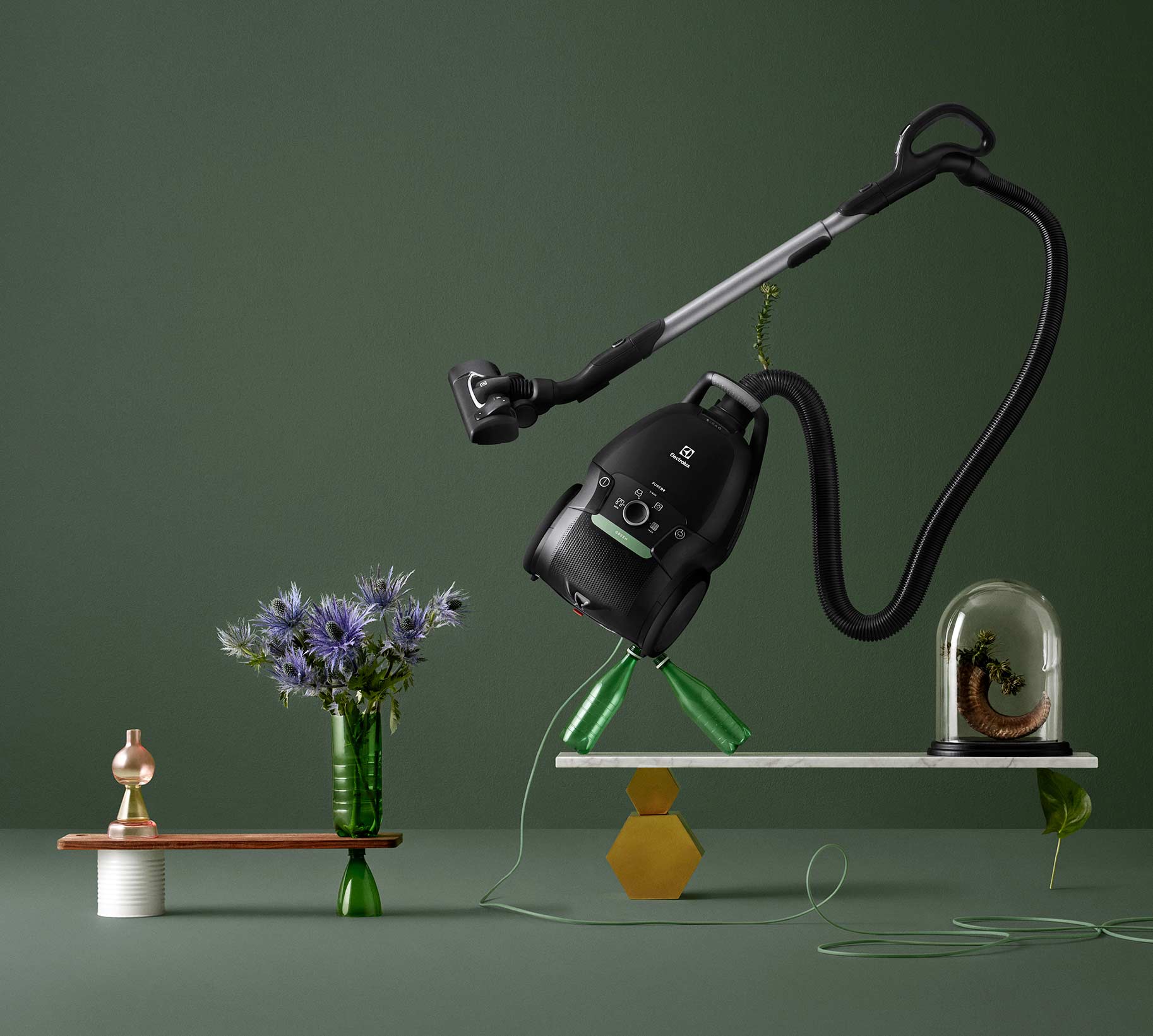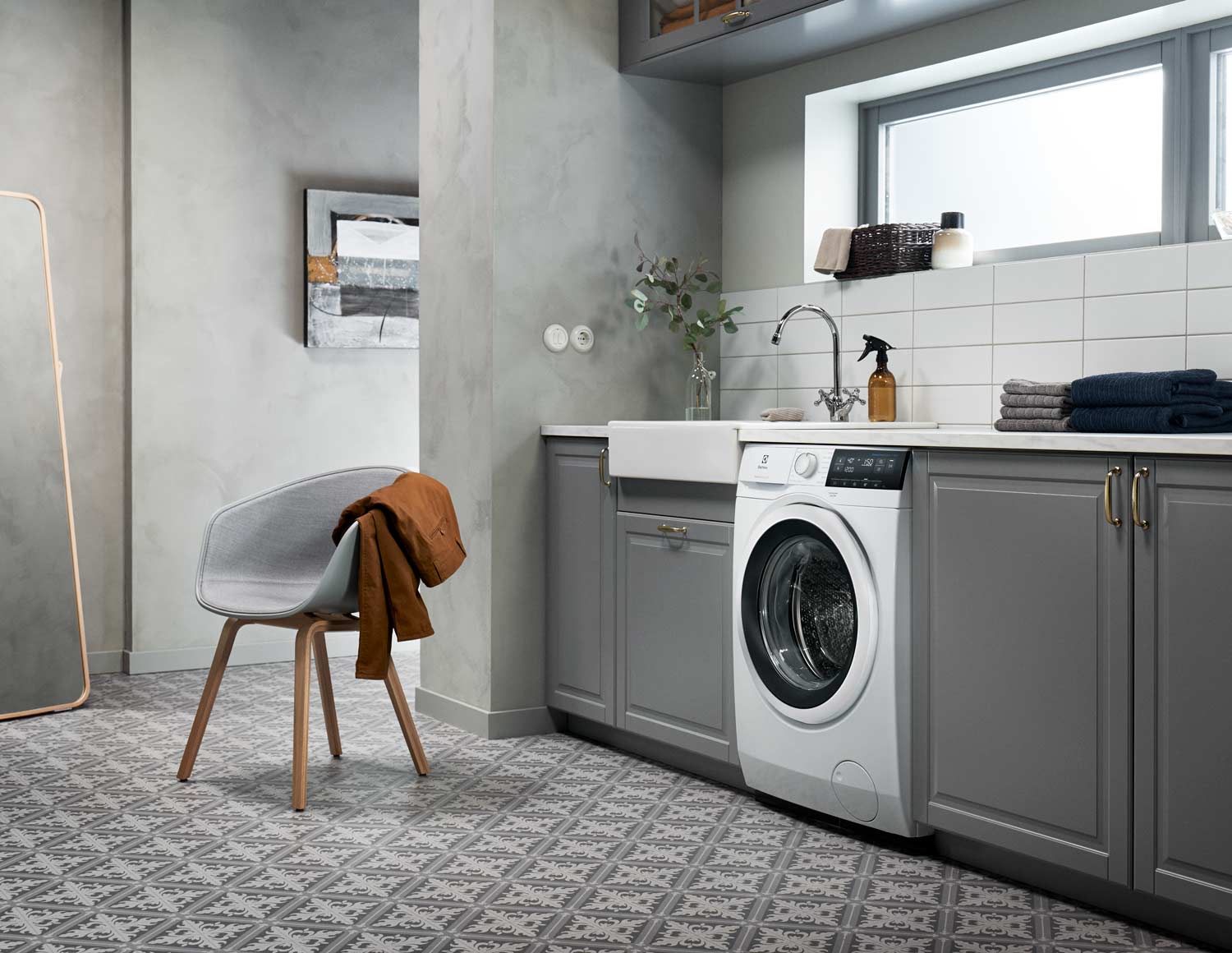Electrolux strives to deliver modularized products in an automated and digital manufacturing setup to maximize efficiency and quality. This allows the delivery of competitively priced products for both the mass and the premium segments. The Group ensures a competitive cost structure by focusing on continuous efficiency improvements.

The manufacturing industry is experiencing a rapid technological transformation driven mainly by digitalization. This is a challenge as well as an exciting opportunity for Electrolux to increase efficiency, improve quality, better serve the customers, and produce Best-in-class solutions with a reduced environmental impact. It is also key in maintaining a competitive edge in the appliance industry, where it is increasingly important to be able to adapt quickly to consumer demands.
A number of initiatives are ongoing to further increase efficiency and reduce costs. The aim is to establish new ways of working that incorporate digital manufacturing, smart automation, modularization, sustainability, and standardization. The foundation for this is a stable and focused organization that strives to minimize complexity and make work practices simpler to deliver products and services of superior quality and high delivery reliability.
Efforts to optimize manufacturing operations are focused on three main areas;
Product competitiveness is enhanced by continuous improvement in all areas, as well as through re-engineering programs. In 2017, comprehensive re-engineering programs were initiated at the refrigerator plant in Anderson, South Carolina, the cooking plant in Springfield, Tennessee, and the refrigerator plant in Curitiba, Brazil. Investments are focused on product architectures, automation and innovation, and will result in efficiency improvements and increases in capacity. The initiatives will lead to an increased level of capital expenditure investments over the coming three to four years.
The investments will bring about increased competitiveness and cost efficiency, while, importantly, opening growth opportunities through the production of innovative products. Competitiveness is further enhanced as new products are to a greater extent designed to allow a higher degree of automation and flexibility in their manufacture.
Digital processes for closer collaboration with Electrolux suppliers and retailers help reduce costs, improve quality and increase flexibility. As part of the digital transformation, Electrolux is building a digitally integrated value chain where manufacturing processes interact with the market to meet current demand. In 2017, one project was launched to connect the machinery in the plants, enabling material tracking and localization and optimization of component flows.
During the year, a new Transportation Management System was launched in North America to track, trace and plan inbound raw material shipments. The automated system relies on a real-time, online database that is delivering cost savings as the company transitions from manual to digitized transportation management processes. In Europe, a new system was introduced that makes it possible to track and trace Electrolux products on 750 transport routes.
The Group’s global economies of scale are clear in the coordination of purchasing raw materials, components and finished products. The global purchasing function coordinates and administers approximately 60% of all purchasing. The Responsible Sourcing program supports the worldwide effort in making the right decisions on suppliers and upholding the sustainability performance of the supply base.

Estimated number of robots installed in Electrolux manufacturing operations.

Up to 70% recycled plastic is used in selected vacuum cleaner models, such as the Electrolux Green Range of vacuum cleaners.
An extensive modularization program is ongoing that lowers product costs and the product development spend through standardized global modular platforms for new products. This entails intense automation and focus on plant architecture. An indication of the increasing level of automation is the number of robots installed in Electrolux factories. In 2017, more than 700 robots were installed and this figure is estimated to more than 1,000 in 2020.
Modularization increases the pace of innovation as it unlocks resources for investment in product development. Furthermore, experience demonstrates that modularization means that the time from product development to market for a new product is reduced by 20–30% and that the investment cost decreases by 15–20%.
Since an increasing number of products are being built on a number of shared modules within the Group, savings can be made at the purchasing stage and, in parallel, increased automation leads to reduced direct payroll expenses. Importantly, modularization also leads to increased flexibility by allowing customization of products at late stages of production. The Group aims to further reduce the number of modules, while fully maintaining the flexibility to customize products at late stages.
The efficiency initiatives continued to yield clear results during the year. Modularization increased in the various product groups and led to increased efficiency in product development, marketing and production.
The Group strives to continuously reduce its variable and structural costs. Through improved ways of working, a higher resource efficiency and increased usage of digital tools and processes, the Electrolux Continuous Improvement Program (ECIP) aims to reduce structural costs.
In addition to Group wide measures to streamline and optimize manufacturing and increase efficiency, each business area works intensively to reduce working capital to release resources that can instead be invested in growth activities. The work focuses primarily on trade receivables, accounts payable and inventory. In 2017, the working capital program resulted in an improvement in net operating working capital (inventories, trade receivables and accounts payable) to SEK 4,305m (4,543), corresponding to 3.3% (3.5) of net sales.
Sustainability is an important transformational driver affecting operational excellence. The product life cycle perspective guides the Group on how to make priorities by quantifying the environmental impacts from raw-material extraction, manufacturing, transportation, use and end-of-life treatment. The most significant environmental impact for Electrolux is carbon emissions as a result of energy consumption when products are used. Accordingly, improving efficiency of products is a top priority, but Electrolux is also committed to reduce the impact from raw materials. The impact from manufacturing and transportation is significantly smaller, but addressed as well.
The Group’s overall target is to reduce the climate impact across the products’ lifecycle by 50% by 2020, relative to 2005 levels. In 2017, Science Based Targets were set to define a long-term roadmap for carbon emission reductions in line with the Paris Agreement, COP21.
Energy use and carbon emissions from operations have high priority, and Electrolux has targets for continuous improvements in absolute and relative reductions. The target for 2020 is a 50% relative improvement compared with 2005, and the average energy consumption per unit produced in 2017 had been reduced by 40%.
Direct carbon emissions from Electrolux operations are closely linked to the use of energy. In addition to continuously reducing energy consumption in operations, Electrolux has set a target that 50% of the total energy should come from renewable energy sources by 2020.
In 2017, 22% of the total energy came from renewable sources. Combined with the energy reduction, this means that carbon emissions from operations have been reduced by 340,000 tonnes of CO2 compared with 2005.
For society as a whole, over 25% of global CO2 emissions derives from the transport sector. Electrolux has set a target to reduce CO2 emissions from transportation by 15% by 2020, and the result in 2017 was in line with the target.
Materials used in household appliances comprise primarily steel, plastic and electronic components. Savings in materials are achieved by optimizing the use of input materials, without compromising product performance and quality. Electrolux has the objective to increase the amount of recycled polypropylene plastics in new products from 5,600 tonnes in 2017 to 20,000 tonnes by 2020. Up to 70% recycled plastic is used in selected vacuum-cleaner models.
Electrolux is working proactively to identify potentially hazardous material. New scientific findings and stakeholder requirements are used to regularly update the Restricted Materials list with the objective of phasing out chemicals of concern.
Water shortage is a major problem in many regions. Electrolux has a long-term commitment to help improve management of limited water resources. Together with World Wildlife Fund, Electrolux has mapped water-related risks associated with Group plants. As a result, the Group has implemented context-based water targets to improve water efficiency in manufacturing by 5% each year in areas with the highest risk for water shortages.
To reduce waste in operations, Electrolux has set a target to introduce Zero Landfill programs at all factories by 2020. The program focuses on identifying the origin of waste, reduction measures and opportunities to reuse materials.

With Electrolux PerfectCare washing machine delicates, woollens and even the hand-wash-only garments can be cared for at home.
-17%
The average water consumption per unit produced in comparable plants has decreased by 17% since 2015.
-35%
The average carbon emission per unit produced has decreased by 35% since 2015.
| Recycling, 1% | 1% |
| Materials, 9% | 9% |
| Manufacturing, 1% | 1% |
| Transportation, 1% | 1% |
| Product usage, 88% | 88% |
It is by reducing use of resources such as power and water during the everyday operation of its appliances that Electrolux can best contribute to a reduction in climate impact. The Group is cutting climate impact over the products’ lifecycle by 50% by 2020 relative to 2005 levels. Approximately 25 million tonnes of CO2-equivalents will be cut in emissions deriving from product use, from production and transportation as well as from the use of greenhouse gases. As of 2017, 15 million tonnes have been cut.
*Calculated as the average of eleven different appliances.
| 2013 | 2014 | 2015 | 2016 | 2017 | |
| Energy per standard unit | 100 | 101 | 99 | 97 | 95 |
| Energy consumption | 100 | 97 | 93 | 89 | 86 |
| CO<sub>2</sub> emissions | 100 | 98 | 98 | 74 | 62 |
| Water consumption | 100 | 91 | 84 | 88 | 72 |